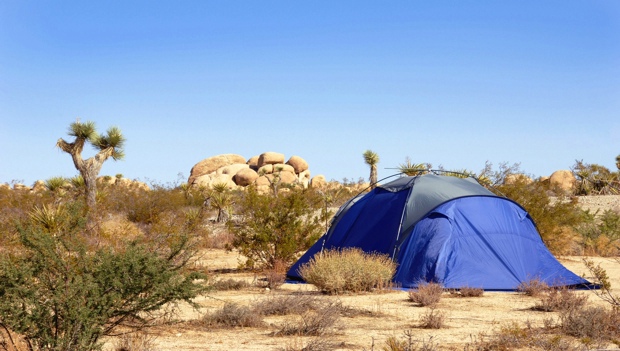
For many, going camping means escaping to the heart of a dense forest, perhaps near a beautiful blue lake or on the bank of a rushing river.
The word desert, meanwhile, conjures up thoughts of arid sand dunes, sun-baked cow skulls and blowing tumbleweeds.
While that image of the desert can be accurate, it's far from complete. At least for those who have witnessed dawn in the desert, as the sun's first rays begin to diminish the evening chill and paint the barren landscape with colors that change seemingly by the minute. Or who have climbed a desert peak to be rewarded with a 360-degree view of an eerily empty world, leaving you feeling as though you were transported to another planet. Or stumbled into an expansive bouquet of wildflowers, their colors magnified by the endless pale desert background upon which they bloom.
The desert can be a land of extreme contradictions—harsh but beautiful, stifling hot to downright cold, bone dry followed by a flash flood, and seemingly barren but actually teeming with life. Which is one of the things that makes it a fascinating place to visit.
And there's a surprising number of things to do—activities such as off-roading and horseback riding; hiking as you explore petroglyphs, abandoned mines and ghost towns; and unparalleled stargazing and nature photography.
More: 8 Places to See Wildflowers This Spring
Enjoying such an environment requires a little extra planning. But taking a few precautions will go a long way toward ensuring a magical time in the desert. Here are some tips for your next—or perhaps your first—desert camping trip.
Before You Go
- Plan the length and location of your trip based on your experience and comfort with desert camping. First-timers may want a short stay at an established campsite, which normally provides access to a vital water supply, as well as other amenities to make the experience easier. The more experienced may prefer a solitary primitive campsite, where you'll likely be required to bring all the water you'll need during your stay.
- Consider the time of year. If triple-digit temperatures don't faze you, you often can find fewer crowds and better rates during the summer. But choosing the winter months will give you the desert experience with much more pleasant temperatures.
- It can take a week or more to acclimate to high heat, so try to adjust gradually to the hotter temperatures if possible.
- Water is life. Unless you've spent time in the desert, it's difficult to truly grasp how dire it is to run out of water. The general guideline is to drink at least a gallon a day—and you should double that if you are doing any kind of strenuous activity. It's far better to end up carrying water you didn't need than to need more and not have it.
- Sun protection is vital. This includes a head covering such as a wide-brimmed hat or bandana, a light-colored long-sleeve shirt and pants, and a pop-up shade shelter for your campsite.
- Get your car checked before you go to make sure everything is working great. A four-wheel drive vehicle is preferred.
- Make sure everyone in your party is familiar with the symptoms and treatment of dehydration, heat exhaustion and heat stroke.


